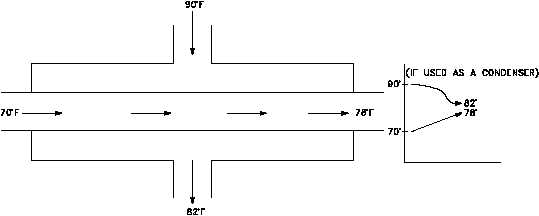TYPES OF HEAT EXCHANGERS
DOE-HDBK-1018/1-93
Heat Exchangers
Cross flow, as illustrated in Figure 5, exists when one fluid flows perpendicular to the
second fluid; that is, one fluid flows through tubes and the second fluid passes around the
tubes at 90 angle. Cross flow heat exchangers are usually found in applications where
one of the fluids changes state (2-phase flow). An example is a steam system's
condenser, in which the steam exiting the turbine enters the condenser shell side, and the
cool water flowing in the tubes absorbs the heat from the steam, condensing it into water.
Large volumes of vapor may be condensed using this type of heat exchanger flow.
Figure 5 Cross Flow Heat Exchanger
Comparison of the Types of Heat Exchangers
Each of the three types of heat exchangers has advantages and disadvantages. But of the three,
the counter flow heat exchanger design is the most efficient when comparing heat transfer rate
per unit surface area. The efficiency of a counter flow heat exchanger is due to the fact that the
average T (difference in temperature) between the two fluids over the length of the heat
exchanger is maximized, as shown in Figure 4. Therefore the log mean temperature for a
counter flow heat exchanger is larger than the log mean temperature for a similar parallel or
cross flow heat exchanger. (See the Thermodynamics, Heat Transfer, and Fluid Flow
Fundamentals Handbook for a review of log mean temperature). This can be seen by comparing
the graphs in Figure 3, Figure 4, and Figure 5. The following exercise demonstrates how the
higher log mean temperature of the counter flow heat exchanger results in a larger heat transfer
rate. The log mean temperature for a heat exchanger is calculated using the following equation.
ME-02
Rev. 0
Page 6

